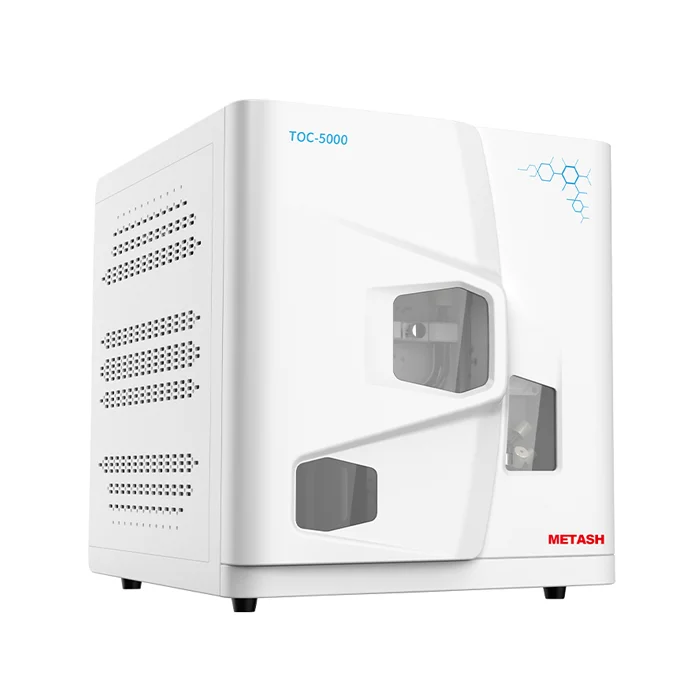Total Organic Carbon (TOC) analysis is a widely recognized method for quantifying the amount of carbon bound in organic compounds present in environmental samples. In soil science and agronomy, TOC measurement serves as a critical indicator of soil health, fertility, and sustainability. In this blog post, Metash, an analytical laboratory instrument manufacturing company, will share the benefits of TOC total organic carbon analyzer for soil testing, from precise soil quality monitoring and improved agricultural productivity, to enhanced environmental protection.

1. Understanding TOC Total Organic Carbon Analyzer for Soil Testing
Organic carbon in soil originates from decayed plant and animal matter, root exudates, microbial biomass, and the decomposition of organic amendments such as compost or manure. It is a major component of soil organic matter (SOM) and plays a pivotal role in nutrient cycling, water retention, soil structure, and microbial activity. TOC concentration in soil can vary significantly depending on climate, vegetation, land use, and management practices.
TOC analysis quantifies the organic fraction of carbon (excluding inorganic carbon such as carbonates and bicarbonates), providing an accurate measure of organic matter contribution to the soil system.
2. Benefits of Laboratory TOC Analyzer for Soil Testing
a. Precise Quantification of Soil Organic Matter
Traditional soil organic matter tests, such as loss-on-ignition (LOI), are semi-quantitative and susceptible to variability due to mineral interference or moisture content. TOC analyzers, particularly those based on combustion or wet chemical oxidation methods, offer precise and repeatable quantification of organic carbon, typically in parts per million (ppm). This accuracy is critical for scientific research, long-term soil monitoring, and high-resolution environmental assessments.
b. Fast and High-Throughput Analysis
Modern TOC analyzers can process multiple samples rapidly using automated sample injection systems and high-temperature combustion techniques. This throughput is especially valuable in large-scale agricultural operations, soil research laboratories, and environmental monitoring programs that require analysis of hundreds or thousands of samples within a short timeframe.
c. Environmental and Land Management Applications
TOC levels in soil are indicative of carbon sequestration potential, which is a vital metric in climate change mitigation strategies. Monitoring TOC allows for quantifying carbon storage in various land use systems such as forests, grasslands, and agricultural fields. Additionally, TOC analysis supports land reclamation projects, erosion control programs, and sustainable farming initiatives by tracking organic matter changes over time.
d. Enhanced Nutrient Management
Soil organic carbon is strongly correlated with nutrient availability, especially nitrogen, phosphorus, and sulfur. Regular monitoring of TOC helps in determining soil fertility and optimizing fertilizer application. By understanding the dynamics of organic matter turnover, farmers and agronomists can implement precision nutrient management strategies, reducing overuse of agrochemicals and minimizing environmental runoff.
e. Soil Health and Microbial Activity Indicator
TOC serves as a proxy for biological activity and microbial biomass in the soil. Healthy soils typically have higher TOC content, which supports diverse microbial communities. Tracking changes in TOC provides insights into the biological status of soil ecosystems and allows for assessment of practices like crop rotation, cover cropping, and organic amendments.

3. Technical Capabilities of TOC Analyzer for Soil Testing
TOC analyzers are equipped with advanced features to handle complex soil matrices. The key technical components include:
* High-Temperature Combustion Furnace (680–1,200 °C): Enables complete oxidation of organic carbon into CO₂ gas.
* NDIR Detector (Non-Dispersive Infrared): Measures the evolved CO₂ with high sensitivity and specificity.
* Sample Preparation Units: Soil samples are typically ground, dried, and acidified to remove inorganic carbon (TIC) before analysis.
* Automation and Software Integration: Automated samplers and robust data processing software ensure streamlined operation and data integrity.
Depending on the sample type and analysis goal, TOC analyzers can operate in different modes:
* TC (Total Carbon): Measures all carbon (organic and inorganic).
* TIC (Total Inorganic Carbon): Determined by acidification and subsequent CO₂ release.
* TOC: Calculated as the difference (TC – TIC) or directly measured through selective oxidation.
4. Applications Across Soil Testing Scenarios
a. Agricultural Soil Monitoring
Farmers and agronomists use TOC analysis to assess long-term soil fertility trends, optimize tillage practices, and evaluate the impact of organic amendments. TOC serves as a benchmark for sustainability and guides regenerative farming practices.
b. Environmental Impact Assessments
Soil TOC levels are crucial for environmental assessments involving contaminated land, industrial development, or infrastructure projects. Elevated organic carbon levels may influence pollutant mobility, while low TOC content can indicate degraded land.
c. Soil Carbon Sequestration Studies
TOC analysis is central to quantifying the carbon sequestration potential of conservation agriculture, agroforestry, and reforestation programs. This data is valuable for carbon trading schemes, climate policy evaluation, and sustainability certifications.
d. Research and Academic Applications
In academic soil science, TOC data is used in modeling soil organic matter turnover, studying microbial ecology, and evaluating pedogenic processes. High-resolution TOC measurements support publication-quality research.
5. Comparison with Alternative Techniques
|
Method |
Principle |
Accuracy |
Limitations |
|
Loss on Ignition (LOI) |
Mass loss at 550°C |
Moderate |
Influenced by water and mineral content |
|
Walkley-Black Method |
Dichromate oxidation |
Moderate |
Hazardous chemicals, incomplete oxidation |
|
TOC Analyzer |
Combustion or wet oxidation |
High |
Initial cost and sample prep required |
TOC analyzers, though more capital-intensive, offer unparalleled accuracy, repeatability, and versatility. Their ability to distinguish between organic and inorganic carbon sets them apart from traditional techniques.
6. Regulatory and Quality Assurance Implications
In regions with environmental regulations around soil health, such as the EU Common Agricultural Policy (CAP) or the USDA's soil conservation initiatives, TOC data is often required for compliance reporting and subsidy eligibility. TOC analyzers provide validated, audit-ready data that meets ISO and ASTM standards (e.g., ISO 10694, ASTM D7573).
Laboratories using TOC analyzers can establish quality assurance protocols including:
* Standard operating procedures (SOPs)
* Certified reference materials (CRM)
* Inter-laboratory comparisons
* Instrument calibration and maintenance logs
Conclusion
The use of TOC analyzer for soil testing offers precise, reproducible, and rapid insights into the organic carbon content of soils—a foundational parameter for assessing soil health, fertility, and environmental sustainability. From agricultural optimization to climate policy implementation, TOC analysis empowers stakeholders with the data needed to make informed decisions.
www.metashcorp.com
Metash
